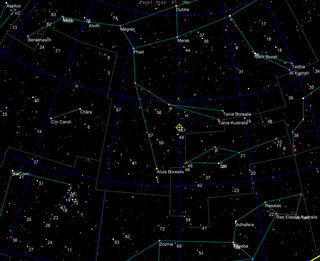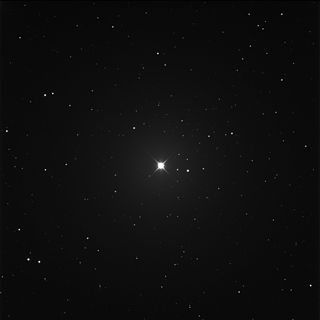
An exoplanet or extrasolar planet is a planet outside the Solar System. The first possible evidence of an exoplanet was noted in 1917 but was not recognized as such. The first confirmation of the detection occurred in 1992. A different planet, initially detected in 1988, was confirmed in 2003. As of 1 January 2024, there are 5,576 confirmed exoplanets in 4,113 planetary systems, with 887 systems having more than one planet. The James Webb Space Telescope (JWST) is expected to discover more exoplanets, and also much more about exoplanets, including composition, environmental conditions and potential for life.

70 Virginis is a binary star located 59 light years from the Sun in the equatorial constellation of Virgo, near the northern constellation border with Coma Berenices. 70 Virginis is its Flamsteed designation. The star is visible to the naked eye as a faint, yellow-hued point of light with an apparent visual magnitude of +4.97. It is drifting further away with a heliocentric radial velocity of +4.4 km/s and has a high proper motion, traversing the celestial sphere at the rate of 0.621 arc seconds per annum.

In astronomy and astrobiology, the habitable zone (HZ), or more precisely the circumstellar habitable zone (CHZ), is the range of orbits around a star within which a planetary surface can support liquid water given sufficient atmospheric pressure. The bounds of the HZ are based on Earth's position in the Solar System and the amount of radiant energy it receives from the Sun. Due to the importance of liquid water to Earth's biosphere, the nature of the HZ and the objects within it may be instrumental in determining the scope and distribution of planets capable of supporting Earth-like extraterrestrial life and intelligence.

47 Ursae Majoris, formally named Chalawan, is a yellow dwarf star approximately 45.3 light-years from Earth in the constellation of Ursa Major. As of 2011, three extrasolar planets are believed to orbit the star.
16 Cygni or 16 Cyg is the Flamsteed designation of a triple star system approximately 69 light-years away from Earth in the constellation of Cygnus. It consists of two Sun-like yellow dwarf stars, 16 Cygni A and 16 Cygni B, together with a red dwarf, 16 Cygni C. In 1996 an extrasolar planet was discovered in an eccentric orbit around 16 Cygni B.

61 Virginis is the Flamsteed designation of a G-type main-sequence star (G7V) slightly less massive than the Sun, located 27.8 light-years away in the constellation of Virgo. The composition of this star is nearly identical to the Sun.
Gliese 777, often abbreviated as Gl 777 or GJ 777, is a yellow subgiant approximately 52 light-years away in the constellation of Cygnus. The system is also a binary star system made up of two stars and possibly a third. As of 2005, two extrasolar planets are known to orbit the primary star.

An eccentric Jupiter is a Jovian planet that orbits its star in an eccentric orbit. Eccentric Jupiters may disqualify a planetary system from having Earth-like planets in it, because a massive gas giant with an eccentric orbit may eject all Earth mass exoplanets from the habitable zone, if not from the system entirely.

HD 164595 is a wide binary star system in the northern constellation of Hercules. The primary component of this pair hosts an orbiting exoplanet. The system is located at a distance of 92 light years from the Sun based on parallax measurements, and is drifting further away with a radial velocity of 2.0 km/s. Although it has an absolute magnitude of +4.81, at that distance it is too faint to be viewed with the naked eye, having an apparent visual magnitude of 7.07. The brighter star can be found with binoculars or a small telescope less than a degree to the east-northeast of Xi Herculis. HD 164595 has a relatively large proper motion, traversing the celestial sphere at an angular rate of 0.222″ yr−1.
4 Ursae Majoris (sometimes abbreviated 4 UMa) is the Flamsteed designation of a star in the northern circumpolar constellation of Ursa Major. It also bears the Bayer designation of Pi2 Ursae Majoris (Pi2 UMa, π2 Ursae Majoris, π2 UMa) and is traditionally named Muscida. With an apparent visual magnitude of +4.6, this star is visible from suburban or darker skies based upon the Bortle Dark-Sky Scale. From parallax measurements made during the Hipparcos mission, this star is at a distance of 256 light-years (78 parsecs) from Earth. As of 2011, one extrasolar planet has been confirmed to be orbiting the star.

Sudarsky's classification of gas giants for the purpose of predicting their appearance based on their temperature was outlined by David Sudarsky and colleagues in the paper Albedo and Reflection Spectra of Extrasolar Giant Planets and expanded on in Theoretical Spectra and Atmospheres of Extrasolar Giant Planets, published before any successful direct or indirect observation of an extrasolar planet atmosphere was made. It is a broad classification system with the goal of bringing some order to the likely rich variety of extrasolar gas-giant atmospheres.

55 Cancri b, occasionally designated 55 Cancri Ab, also named Galileo, is an exoplanet orbiting the Sun-like star 55 Cancri A every 14.65 days. It is the second planet in order of distance from its star, and is an example of a hot Jupiter, or possibly rather "warm Jupiter".

Gliese 876 c is an exoplanet orbiting the red dwarf Gliese 876, taking about 30 days to complete an orbit. The planet was discovered in April 2001 and is the second planet in order of increasing distance from its star.

16 Cygni Bb or HD 186427 b is an extrasolar planet approximately 69 light-years away in the constellation of Cygnus. The planet was discovered orbiting the Sun-like star 16 Cygni B, one of two solar-mass (M☉) components of the triple star system 16 Cygni in 1996. It orbits its star once every 799 days and was the first eccentric Jupiter and planet in a double star system to be discovered. The planet is abundant in lithium.

Upsilon Andromedae b, formally named Saffar, is an extrasolar planet approximately 44 light-years away from the Sun in the constellation of Andromeda. The planet orbits the solar analog star, Upsilon Andromedae A, approximately every five days. Discovered in June 1996 by Geoffrey Marcy and R. Paul Butler, it was one of the first hot Jupiters to be discovered. It is also one of the first non-resolved planets to be detected directly. Upsilon Andromedae b is the innermost-known planet in its planetary system.

47 Ursae Majoris b, formally named Taphao Thong, is a gas planet and an extrasolar planet approximately 46 light-years from Earth in the constellation of Ursa Major. The planet was discovered located in a long-period orbit around the star 47 Ursae Majoris in January 1996 and as of 2011 it is the innermost of three known planets in its planetary system. It has a mass at least 2.53 times that of Jupiter.

47 Ursae Majoris c, formally named Taphao Kaew is an extrasolar planet approximately 46 light-years from Earth in the constellation of Ursa Major. The planet was discovered located in a long-period around the star 47 Ursae Majoris. Its orbit lasts 6.55 years and the planet has a mass at least 0.540 times that of Jupiter.

Epsilon Eridani b, also known as AEgir [sic], is an exoplanet approximately 10.5 light-years away orbiting the star Epsilon Eridani, in the constellation of Eridanus. The planet was discovered in 2000, and as of 2023 remains the only confirmed planet in its planetary system. It orbits at around 3.5 AU with a period of around 7.6 years, and has a mass around 0.6 times that of Jupiter. As of 2023, both the Extrasolar Planets Encyclopaedia and the NASA Exoplanet Archive list the planet as 'confirmed'.
HD 210277 b is an extrasolar planet orbiting the star HD 210277. It was discovered in September 1998 by the California and Carnegie Planet Search team using the highly successful radial velocity method. The planet is at least 24% more massive than Jupiter. The mean distance of the planet from the star is slightly more than Earth's distance from the Sun. However, the orbit is very eccentric, so at periastron this distance is almost halved, and at apastron it is as distant as Mars is from the Sun.

An exoplanet is a planet located outside the Solar System. The first evidence of an exoplanet was noted as early as 1917, but was not recognized as such until 2016; no planet discovery has yet come from that evidence. What turned out to be the first detection of an exoplanet was published among a list of possible candidates in 1988, though not confirmed until 2003. The first confirmed detection came in 1992, with the discovery of terrestrial-mass planets orbiting the pulsar PSR B1257+12. The first confirmation of an exoplanet orbiting a main-sequence star was made in 1995, when a giant planet was found in a four-day orbit around the nearby star 51 Pegasi. Some exoplanets have been imaged directly by telescopes, but the vast majority have been detected through indirect methods, such as the transit method and the radial-velocity method. As of 1 January 2024, there are 5,576 confirmed exoplanets in 4,113 planetary systems, with 887 systems having more than one planet. This is a list of the most notable discoveries.

















